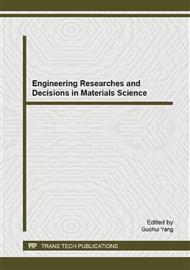p.80
p.86
p.92
p.98
p.104
p.110
p.115
p.120
p.126
Synthesis and Characterization of High Density and Low Temperature Sintered Proton Conductor BaCe0.5Zr0.35In0.1Zn0.05O3-δ
Abstract:
Rare-earth-doped BaCeO3 and BaZrO3 electrolytes with perovskite structure have been studied extensively in developing proton conducting intermediate temperature SOFC. Acceptor doped alkaline earth cerates and zirconates have been thoroughly studied because of the great interest in their possible applications as solid proton conductors. The perovskite type proton conductor BaCe0.5Zr0.35In0.1Zn0.05O3-δwas prepared in the traditional solid state reaction method. The density of the sample obtained about 96% of the theoretical density after sintering at 1350 °C and X-ray diffraction study confirms the pure phase. Rietveld refinement of the neutron and X-ray powder diffraction data shows that this material crystallizes in the orthorhombic symmetry in the space group Pm3m. Particle size measurement shows that the average particle size is about 2.4 μm. The average thermal expansion at 894 °C was 9.49 x 10-6/°C. Thermogravimetric analysis (TGA) traces obtained for the sample on heating in wet air shows that the maximum proton uptake occurs from 595 °C.
Info:
Periodical:
Pages:
104-109
Citation:
Online since:
April 2015
Authors:
Price:
Сopyright:
© 2015 Trans Tech Publications Ltd. All Rights Reserved
Share:
Citation:


